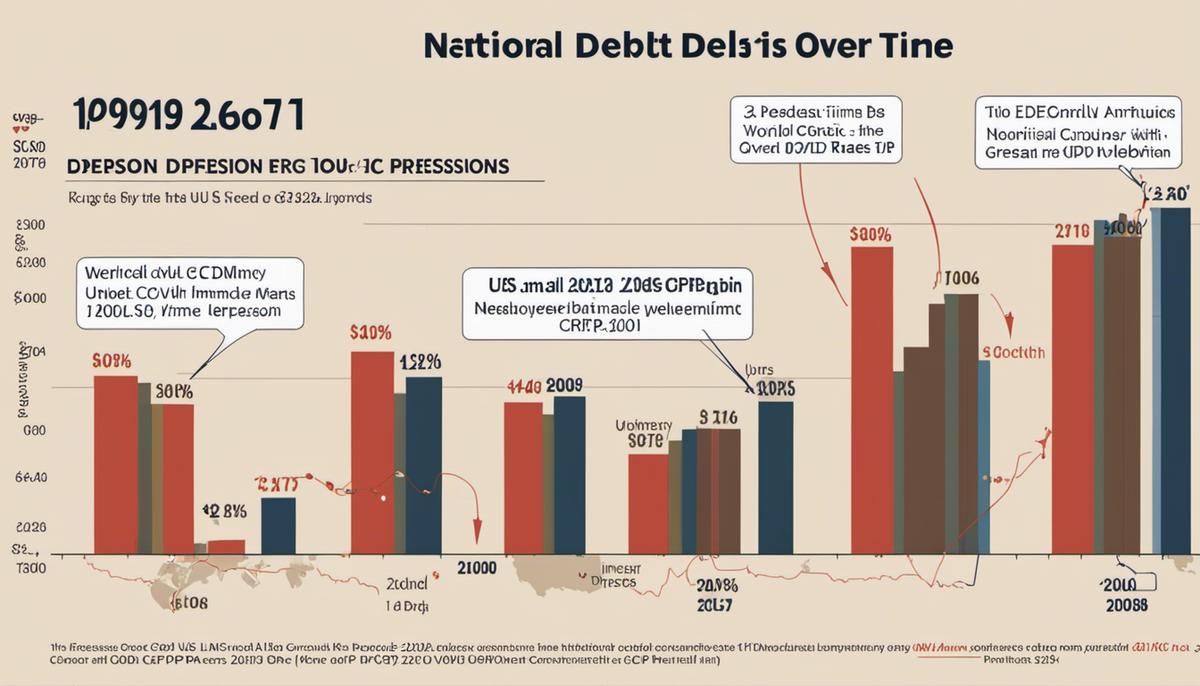Throughout history, the United States has been faced with numerous economic challenges, among them, one of the most significant being its national debt. The patterns and implications of this vast and complex debt, accrued over centuries, warrant comprehensive examination. The present essay embarks on a journey, diving into the historical foundations of US debt, investigating its key triggers across various significant periods such as the World Wars, the Great Depression, the 2008 financial crisis and the ongoing COVID-19 pandemic. In this quest, it delineates the overarching impact of this escalating debt on the domestic economy and the global economic landscape, and deliberates over potential policy cum strategy responses.
Table of Contents
Understanding the US National Debt
The Historical Origins and Evolution of the US National Debt: A Comprehensive Analysis
The United States national debt is a subject that continues to dominate financial, political, and even social discourse across the globe. Often, it is portrayed as an unwieldy, nearly insurmountable burden. Nevertheless, to understand it fully, one must delve deeper into its roots and evolutionary trajectory over centuries.
Understanding the origins of the national debt of the United States necessitates a journey back to the nation’s earliest years. Indeed, the genesis of the US national debt can be traced to its revolutionary inception during the late 18th century. By the end of the Revolutionary War in 1783, the United States, then a collection of newly independent states, had amassed substantial debts totaling around $79 million (a significant figure at the time). To manage these arrears, the Treasury Department was established in 1789, with Alexander Hamilton as the first Secretary. He proposed the federal government assume states’ debts, contending that a shared burden might help bind the infant nation. Consequently, the national debt began to grow under a centralized fiscal policy.
The progression of the 19th century saw alterations in the national debt due to different governmental philosophies and external events. Jefferson’s Louisiana Purchase in 1803 exponentially expanded national territory but also the national debt. Furthermore, fiscal strains from the War of 1812 and the Mexican-American war had substantial impacts on the national debt growth. However, episodes of economic growth during the era of Manifest Destiny led to considerable debt reductions, even achieving a brief moment in 1835 when the debt was entirely paid off.
However, the tranquility was fleeting. The Civil War propelled the national debt from $65 million in 1860 to an overwhelming $2.7 billion by 1865, introducing the concept of war bonds and institutionalizing the debt trend. As the 20th century dawned, countervailing economic and military phenomena saw the national debt gyrate tremendously, rising during periods of war (World War I, World War II) and recession (the Great Depression) while falling during periods of prosperity.
Post-World War II, the introduction of the Bretton Woods system and the establishment of the International Monetary Fund and World Bank reframed the global economic structure with the US dollar at its crux. This scenario allowed for the sustenance of high debt levels while facilitating international trade, further boosting the US national debt.
The advent of the 21st century brought the national debt under glaring spotlight due to international terrorism and domestic economic policies. The financial cost of the war on terror ballooned the national debt. The financial crisis of 2007–2008 served to compound this, and the various economic recovery programs implemented in its wake, such as the Troubled Asset Relief Program (TARP), only added more to the growing debt.
Undeniably, the COVID-19 pandemic adds another chapter in this extensive history, driving unprecedented fiscal responses that continue to push the national debt to new heights.
It is crucial to remember that understanding the United States’ national debt requires taking a long temporal view, one that respects the intricate financial history woven into the fabric of American progress. Each era has seen, responded to, and shaped the national debt, and understanding these layers gives one a more profound comprehension of this mammoth fiscal phenomenon.

Implications of a Rising National Debt
As we delve deeper into the effects of a rising national debt on the US economy and its citizens, it is crucial to acknowledge one essential fact: the national debt is not an isolated economic variable. It exists within a complex financial structure that includes global and domestic markets, interest rates, the Federal Reserve policy, and overall economic growth.
One of the clear impacts of a rising national debt is the potential increase in interest rates. This rise can occur as a result of the government borrowing heavily to finance its budget deficit. A larger pool of debt can lead to increased competition for funds, causing the rates to trend upwards. Simultaneously, an expanding national debt can also predispose a country to inflationary pressures, especially if the borrowed money is used to stimulate demand in an already booming economy. The ripple effects of high interest rates and inflation are numerous, from increased costs of borrowing, depressed investment and economic slowdown, to a diminished purchasing power for consumers – which directly impacts the citizens’ standard of living.
Notably, however, a rising national debt can also exert subtler effects on the economy. It clouds economic outlook, introducing uncertainty and nervousness that constrain both business investment and consumer spending. It also dampens the government’s ability to respond to future crises – fiscal or otherwise. The more indebted a nation, the thinner is its cushion to absorb and recover from shocks, therefore exposing its citizens to the potential of severe hardships during downturns.
At times, a prominent argument is shrouded in the notion that the current generation is ‘burdening’ the future generations with high levels of national debt. This argument combines both economic and ethical implications. The economic aspect underlines the potential for decreased investment, subdued economic growth, and lower future standards of living. On the moral side, it underscores the unfairness of present consumption that necessitates the future generation to bear its cost.
Ironically, despite the profound weight attributed to the national debt, it never operates in isolation from other economic considerations. Observing the US economy, one can identify times when increased national debt coincided with periods of economic boom, as increased government spending provided necessary stimulus to spur growth. Therefore, interpreting the nuanced influences of national debt on the US economy and its citizens requires more than a fiduciary lens; it calls for a thorough understanding of the broader economic framework within which this debt is nestled.
The discourse surrounding the national debt and its impacts is a continual source of insightful study and revelations. As the national debt grows and evolves in response to ever-changing fiscal, monetary, and crisis dynamics, the fascinating intricacies of such a relationship between borrowing, economy, and citizen welfare keep scholars, practitioners, and policymakers engaged in ceaseless exploration and discovery.
As we wrap up this exploration and continue our journey into the monumental domain of national debt, we end with the realization that navigating such interconnected financial landscapes is both a challenging and captivating endeavor, illuminating the dyadic interaction between economics and the world we live in where these concepts come alive. And though we leave without a reiterative conclusion, the endeavor continues, as the complexities of national debt remain a subject of ongoing research, discussion, and understanding.

Public versus Private Debt in the US
To comprehend the integral relationship between public and private debt in contributing to the overall US national debt dynamics, this discourse delves into several key facets, dissecting the contours of this often complex equation.
At the surface level, public debt and private debt are seemingly contrasting entities—public debt implies the sum owed by the Federal government, usually raised through issuing securities and treasury bills, while private debt denotes the money owed by private sector entities, such as individuals, businesses, and non-profit organizations, primarily through loans and credit. However, on a deeper level, a close symbiosis exists.
Public debt often derives from budget deficits where federal expenditure surpasses revenue. With increasing public debt, the government may resort to borrowing from private entities, thereby indirectly inflating the private debt spectrum. This transfer of debt from public entities to private players not only elevates the overall national debt but directly influences the dispensation of private sector capital, often diverting it from potentially productive areas. Consequently, the interplay between public and private debt is intrinsic to understanding the broader trajectory of US national debt.
Because of private debt’s nature, it forms a consequential facet of consumer spending, contributing significantly to economic growth. However, excessive private borrowing can escalate the risk of financial instability, as witnessed during the 2007-2008 financial crisis. In response, the government may choose to intervene, absorbing portions of this private debt through bailouts or the assumption of toxic assets, thereby curtailing immediate systemic risk but expanding the public debt scale in the process.
The securitization of private debt, and its subsequent sale to the public sector, has led to the intertwined destiny of these two debt arenas. The 2008 financial crisis was a stark example, where subprime mortgage debts consolidated into securities were resold to entities around the globe, spearheading the crisis when the bubble burst. Therefore, although these debts start as private, their ramifications are publicly experienced and their burden communally shared.
Moreover, it is vital to acknowledge the role played by external factors, such as sudden global pandemics, geopolitics, or market volatility that can ignite rapid alterations in the balance of public and private debt. These dynamics heighten the economic unpredictability, exacerbating the fluid interplay between public and private debt, and thereby, overall national debt.
Finally, the evolving nature of the financial sector—with the advent of complex financial instruments, multiple debt markets, increased globalization, and inter-country borrowings—further complicate this narrative, making the behavior, control, and analysis challenging yet indispensable.
In conclusion, the equation between public and private debt and their cumulative contribution to the overall national debt in the US is a dance of intricacies, under continual evolution. The multifarious interactions, dynamic external influences, and changing economic landscapes dictate the construct of this dance. Hence, to fully appreciate this phenomenon, it becomes imperative to employ a holistic, informed lens that understands and respects these complexities.

The Global Perspective of US National Debt
Despite the exhaustive historical assessment of the U.S. national debt, it stands paramount to underscore its function in the international economic landscape. Comprehending the national debt’s global impact necessitates a deep understanding of the United States’ position as a leading global economic actor and the integral part the U.S. dollar plays in international finance.
To delve into this, it is crucial to first identify the unique position the U.S. occupies as the issuer of the world’s primary reserve currency. The dollar’s global significance lends the U.S a peculiar ability to engage in what is referred to as “deficit without tears”. This implies that the nation can finance its deficits by merely printing more dollars or issuing dollar-denominated debt, as these enjoy an insatiable global demand due to the dollar’s safe-haven status in periods of economic uncertainty.
Additionally, the role of U.S. Treasury bonds as global risk-free assets must be appreciated. Owing to the dollar’s inflation stability, U.S. bonds are often deemed the safest investments globally. They form the basis of many countries’ foreign exchange reserves, with foreign entities holding up to one-third of the U.S. national debt. This cements the dollar’s status as the world’s de facto global currency.
However, this does not immunize the U.S from the potential side effects of an escalated national debt. The possibility of a declining demand for U.S bonds, leading to an increased dollar interest rate, can devalue international monetary reserves and influence global financial stability.
Alarming questions of a potential “tipping point” have been raised, where investors could lose confidence in the U.S.’s ability to manage its debt, triggering global financial distress. However, empirical evidence for this remains elusive, and these fears often overlook the intricate realities of a fiat-currency-denominated debt where the U.S. has sovereign control.
Moreover, U/S. fiscal and monetary policy reverberates worldwide due to the dollar’s dominant role, thereby linking the U.S’s debt to international macroeconomic stability. A surge in U.S interest rates can escalate borrowing costs globally, potentially plunging emerging market countries with large dollar-denominated debts into crisis.
Conclusively, the U.S’s national debt plays a pivotal part in shaping global economic conditions, an attribute rooted mainly in the dollar’s global status and the country’s economic influence. Nonetheless, the prospect that the U.S.’s vast national debt may potentially precipitate a global crisis needs to be addressed with insightful economic deliberation, conscious of unprecedented intricacies and vast uncertainties inherent in the global economic landscape.

Addressing US National Debt: Policy and Strategies
Proposing Strategies for Managing U.S. National Debt
In the context of managing the U.S. national debt, several strategies and policies can be proposed. These revolve around economic growth acceleration, fiscal responsibility, entitlement reform, and monetary policy.
Arguably, the most critical method is re-dynamizing economic growth, with taxation and spending adjustments tailored to encourage private investment and leverage public finances’ effectiveness. Adopting reform initiatives, such as tax reforms that broaden the base while constricting income tax rates and corporate taxes, are potential steps towards this direction.
In combination with efforts to broaden the tax base, policy adjustments in spending, particularly discretionary spending, hold significant promise. Fiscal responsibility, when effectively applied, can result in reduced and further controlled public expenditure. This approach can work best when woven into the tapestry of long-term goals to reduce the structural deficit clinically.
Similarly, entitlement reform is worthy of high-level engagement, considering public finance’s trajectory. Reforms to entitlement programs like Social Security and Medicare are complex, necessitating meticulous evaluation of consequences while balancing the need for sustainability with the promise of societal safety nets. The challenge lies in reaching a consensus amidst polarized viewpoints, yet it represents an important part of the solution to the national debt conundrum.
Furthermore, debt management strategies such as extending average maturity of the debt can potentially reduce financial vulnerability. The U.S. Treasury has considerable room to issue more long-term bonds, capturing the benefits of historically low interest rates, while reducing refinancing risks.
On a more intrinsic level, the role of monetary policy cannot be overlooked. The association between sovereign debt issues and monetary policy is profound, yet paradoxical. The traditionally conceived role of central banks in debt management was displaced by the focus on inflation targeting. However, after the 2008 financial crisis, the increased cooperation between fiscal and monetary policy saw a return of the central bank’s prominence in debt management. This suggests the potential for astute application of monetary policy as a significant element in a comprehensive national debt management strategy.
However, these proposals are not without potential pitfalls and controversies. Economic stimulus, fiscal austerity, entitlement reforms, and extended debt maturity can have a wide array of macroeconomic impacts, affecting employment, growth, and inflation. Therefore, the implementation of these strategies should be preceded by robust policy debates, where a wide array of potential outcomes are considered and preparations are made to mitigate possible unforeseen consequences.
While addressing the U.S. national debt is an urgent agenda, it is crucial to approach it with an appreciation for the complex socio-economic textures it is tangled within. There is no quick fix, no magic bullet to obliterate the issue. Rather, it calls for a concerted-long term effort where strategies and policies are not just economically sound but also socially and politically feasible. As we strive for fiscal stability, let’s ensure this pursuit does not compromise our other noble commitments to social stability, sustained economic growth, and maintained public trust in our financial institutions and government.

The United States, as one of the world’s leading economies, bears a role of pivotal significance on the global stage. The nation’s handling of its substantial debt has far-reaching effects not only for its own citizens but also for the global economic stability. Therefore, judicious policy making and strategic planning become imperative to manage this colossal debt. This essay has endeavored to elucidate the various dimensions of the US national debt and its implications, shedding light on potential measures to address this crucial issue. Consequently, it serves as a stepping stone to deepen our understanding and foster informed discourse on dealing America’s colossal debt.

Matt Smith is a seasoned journalist and author whose expertise spans across the dynamic realms of Politics, Gadgets, Gaming, and a plethora of general interest topics. With a Master’s in Political science and tech pedigree shaped in Silicon Valley, Matt brings a wealth of knowledge and a critical eye to everything he writes.
Politics: Matt offers sharp political commentary, drawing from his experience as a political analyst and his academic rigor.
Gadgets: His tech insights are grounded in real-world experience, having been on the front lines of innovation with a degree from Caltech.
Gaming: A respected voice in gaming, Matt’s reviews and trend analyses are a testament to his deep involvement in the gaming community.
General Topics: From science to culture, Matt’s writing spans a broad spectrum, engaging readers with a blend of expertise and relatable prose.
Engage with Matt’s compelling content for a fresh perspective on the issues at the forefront of today’s discourse.

